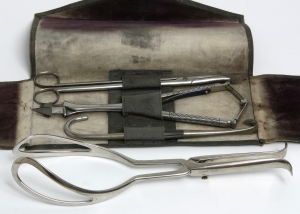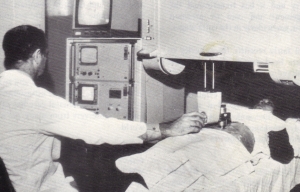Maws & Bairns: Maternal & Child Health in Tayside
Obstetric Practice
 David Kinloch 1559-1617
David Kinloch 1559-1617
David Kinloch, Royal Physician to King James VI, gave the first account of obstetric practice in Scotland in the form of lengthy Latin verse in the second volume of Delitiae Poetarum Scotorum. His portrait is in the Boardroom at Ninewells and he is buried in the Howff in Dundee.
In De Hominis Procreatione, which is dedicated to his fellow poet the King,he gives a somewhat lurid account of the sexual act, but there is also much sensible and practical account of fertility, pregnancy, foetal development and delivery, including posture during pregnancy, breech delivery and retained placenta.
The image to the left shows the title page of De Hominis Procreatione, courtesy of Ninewells Library
Maternal Mortality
In the 19th and first half of the 20th century, everyone knew about death in childbirth, maternal infection being the biggest danger.
In the 1840s, Ignaz Semmelweis noted high rates of maternal mortality in the Vienna clinic attended by medical students. He believed that something was being transmitted from their post-mortem examinations, and by insisting on hand-washing in chlorinated water, mortality reduced from 11.4% to 1.3%. Unfortunately he delayed publication and his ideas were dismissed.
In contrast, the American physician Oliver Wendall Holmes was widely read. He referred to “the pestilence carriers of the lying-in chamber”, but was vilified by the medical profession.
Less well known is that 50 years earlier, after observing the outcome of an epidemic of puerperal fever in Aberdeen, the same conclusion was reached by Alexander Gordon: “it is a disagreeable fact that I, myself, was the means of carrying the infection to a great number of women”. His suggestion of burning bedclothes and fumigating doctors and nurses was not well received and he was hounded from the city.
Gordon, Semmelweis and Holmes showed the answer to puerperal infection, but it was only accepted with extreme reluctance by the medical profession. It was not until 1863 that Louis Pasteur revealed the role of micro-organisms in causing putrefaction, and 1879 before he identified streptococci from women stricken with puerperal sepsis.
Maternal mortality improved with the advent of Lister’s antisepsis, and later asepsis (clean instruments, clean hands, masks and rubber gloves), although the mortality rate in the UK was still around 4 per 1000 live births in the 1920s. This only fell dramatically from the mid-1930s with the advent of sulphonamides (and later penicillin), better nutrition and probably reduced virulence of streptococci.
The other major causes of maternal mortality relate to haemorrhage, convulsions from eclampsia and illegal abortion. The effects of these are now greatly reduced in the UK with the development of caesarean section, ergometrine, blood transfusion, good antenatal care and the 1967 Abortion Act. Sadly, however, this cannot be said for the developing world.
The photo on the right shows early obstetric instruments from the Tayside Medical History Museum's collections (DUNUC 4469 & 8094)
Home or Hospital?
In Victorian times, mid wives were often viewed as unskilled and ill-equipped. Following the Midwives (Scotland) Act of 1915, the new Central Midwives Board ensured compulsory training and examination of every midwife, and when the National Health Service was born in 1948 maternity care was very much led by these highly skilled and respected professionals.
wives were often viewed as unskilled and ill-equipped. Following the Midwives (Scotland) Act of 1915, the new Central Midwives Board ensured compulsory training and examination of every midwife, and when the National Health Service was born in 1948 maternity care was very much led by these highly skilled and respected professionals.
The photo on the left shows a 1924 certificate of Nursing training at DRI for Nurse Beddie from the Tayside Medical History Museum's Collections (DUNUC 4381)
In 1923, 71% of Dundee’s births took place in the community, with the city’s 24 midwives attending almost half of these. During the 1960s there was a fierce debate about whether childbirth should take place at home (for its intimate atmosphere) or in hospital (for its safety features).
Hospital obstetrician-led birth was to dominate for the next 30 years, but more recently traditional midwifery care and patient empowerment have led to the development of Community Midwife Units (CMUs) for women who fit agreed  low-risk criteria. In Tayside, those deemed to be at increased risk of complications or who wish epidural for pain relief give birth in Ninewells Labour Suite. In 2011, 1,286 babies were delivered by the CMUs at Ninewells, Perth, Arbroath and Montrose; 3,459 arrived in the Labour Suite; and 16 were born at home.
low-risk criteria. In Tayside, those deemed to be at increased risk of complications or who wish epidural for pain relief give birth in Ninewells Labour Suite. In 2011, 1,286 babies were delivered by the CMUs at Ninewells, Perth, Arbroath and Montrose; 3,459 arrived in the Labour Suite; and 16 were born at home.
The photo on the right shows the last baby born at Dundee Royal Infirmary (on left) and the first baby born at Ninewells (on right), 1974, from Private collection
Pain Relief
1847 was a momentous year for furthering relief of pain in childbirth. January saw the first use of ether as an anaesthetic in obstetrics by James Young Simpson in Edinburgh. Just ten months later, Simpson discovered, trialled, announced to a medical society and published in the Lancet the first anaesthetic use of chloroform, all this in the course of 16 days!
However, the advent of anaesthesia in obstetric practice was not welcomed by all, and Simpson had to fight against those who opposed their use on professional or religious grounds. It was Queen Victoria who was to be his most influential champion by having her 8th and 9th children with the aid of chloroform, and her enthusiastic endorsement subsequently popularised its use.
Nowadays, options available for the relief of pain during childbirth include epidural anaesthesia and hydrotherapy. Entonox was first announced to the medical profession in 1961.
Obstetric Ultrasound
It is only in the past 50 years that ult rasound has been used for medical diagnosis. Its use in obstetrics for foetal orientation, estimation of foetal growth and locating the position of the placenta was introduced to Tayside in the early 1970s by Dr A D Christie. By the 1980s, ultrasound was considered the best screening technique for detecting structural defects in early pregnancy.
rasound has been used for medical diagnosis. Its use in obstetrics for foetal orientation, estimation of foetal growth and locating the position of the placenta was introduced to Tayside in the early 1970s by Dr A D Christie. By the 1980s, ultrasound was considered the best screening technique for detecting structural defects in early pregnancy.
The photo on the left shows an ultrasound machine from the mid-1970s, courtesy of Tayside Health Board